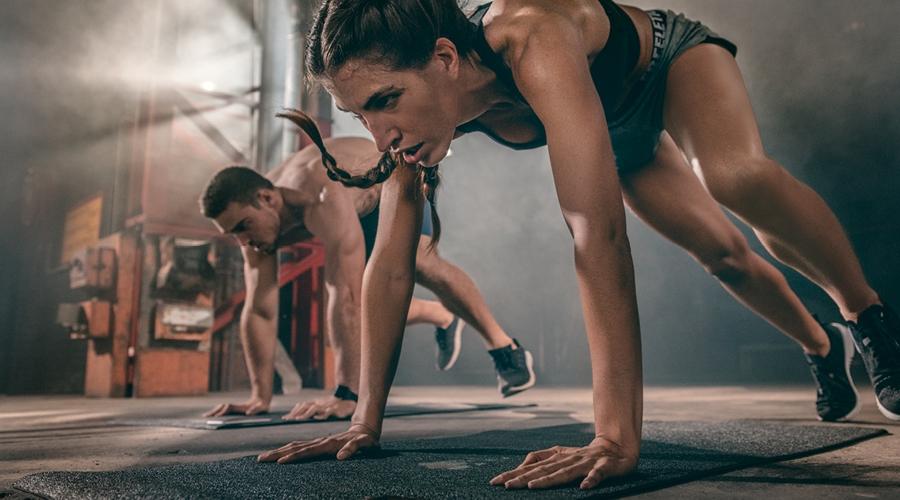
Are you tired of spending hours at the gym without seeing the results you want? It’s time to switch up your workout routine and incorporate the ultimate workout combo: HIIT after lifting. High-intensity interval training (HIIT) and weightlifting have both been proven to be effective for building muscle, burning fat, and improving overall fitness. But when you combine the two, the benefits are even greater.
In this blog post, we’ll dive into the science behind why post-lifting cardio is the ultimate workout combo. We’ll explore how HIIT and lifting work together to maximize results and improve overall fitness. Additionally, we’ll provide tips on how to incorporate HIIT into your lifting routine, including sample workouts and recommendations for timing and frequency.
So, whether you’re a seasoned gym-goer looking to shake up your routine or a beginner trying to optimize your workouts, this post is for you. Get ready to take your fitness to the next level with the ultimate workout combo: HIIT after lifting.
The Science Behind HIIT After Lifting
When you lift weights, your body undergoes a process called hypertrophy, where your muscle fibers become damaged and then repair themselves, resulting in increased muscle mass and strength. While lifting weights is excellent for building muscle, it doesn’t do much to improve cardiovascular fitness.
This is where high-intensity interval training (HIIT) comes in. HIIT involves short bursts of intense exercise, followed by periods of rest or low-intensity exercise. During the high-intensity intervals, your body relies primarily on carbohydrates for energy, while during the rest periods, it switches to burning fat.
When you combine HIIT with weightlifting, you get the best of both worlds. Lifting weights causes your body to use up its carbohydrate stores, meaning that when you transition to a HIIT workout, your body is forced to burn fat for energy. This can help you burn more fat overall and improve cardiovascular fitness.
Furthermore, the increased muscle mass from weightlifting means that your body will burn more calories at rest, allowing you to achieve a higher overall caloric burn during your post-lifting HIIT workout. This combination of strength training and HIIT has been shown to be highly effective for increasing overall fitness and improving body composition.
Benefits of Combining Strength Training and HIIT
Combining strength training and high-intensity interval training (HIIT) offers a variety of benefits that neither type of exercise can provide on its own. Here are just a few:
- Increased Muscle Mass: Strength training is excellent for building muscle mass, and combining it with HIIT can enhance those gains even further. This is because the high-intensity intervals of a post-lifting HIIT workout help to stimulate muscle fibers that may not have been activated during weightlifting alone.
- Accelerated Fat Loss: HIIT is known for its ability to burn fat, and combining it with strength training can help accelerate fat loss even further. This is because the increased muscle mass from weightlifting means that your body will burn more calories at rest, allowing you to achieve a higher overall caloric burn during your post-lifting HIIT workout.
- Improved Cardiovascular Fitness: While strength training is excellent for building muscle, it doesn’t do much to improve cardiovascular fitness. HIIT, on the other hand, has been shown to improve cardiovascular fitness by increasing heart rate and oxygen consumption. Combining strength training and HIIT can help improve both muscle mass and cardiovascular fitness, leading to overall improved health.
- Time Efficiency: Combining strength training and HIIT into one workout allows you to achieve a full-body workout in a shorter amount of time. This is because you are targeting both muscle building and fat burning in the same workout, rather than having to do two separate workouts on different days.
- Break Through Plateaus: If you’ve hit a plateau in your workout routine, combining strength training and HIIT can help you break through it. By challenging your body in a new way, you can stimulate muscle growth and improve overall fitness.
Overall, combining strength training and HIIT offers a highly effective way to improve body composition, cardiovascular fitness, and overall health.
Read more about Winstrol Results After 2 Weeks

Tips for Designing a Post-Lifting HIIT Workout
Designing a post-lifting HIIT workout can be a highly effective way to enhance your overall fitness routine. Here are some tips to help you design a workout that’s safe and effective:
- Choose the Right Exercises: When selecting exercises for your post-lifting HIIT workout, it’s important to choose ones that complement your lifting routine. For example, if you’ve just done a heavy leg day, you may want to focus on upper body exercises during your HIIT workout. Additionally, choose exercises that allow you to maintain good form even when fatigued.
- Time Your Workout Properly: It’s generally recommended to wait at least 30 minutes after lifting weights before starting your post-lifting HIIT workout. This allows your body to recover and replenish its carbohydrate stores. Additionally, keep your HIIT workout relatively short, as high-intensity exercise can be taxing on the body. Aim for 20-30 minutes of total work time.
- Choose the Right Intensity: When doing high-intensity exercise, it’s important to choose an intensity level that’s appropriate for your fitness level. This means pushing yourself to your limits, but not to the point of exhaustion or injury. A good rule of thumb is to aim for an intensity level that feels “hard but doable.”
- Use a Timer: Timing your intervals is essential for a successful post-lifting HIIT workout. You can use a timer app on your phone or a stopwatch to time your high-intensity intervals and rest periods. A common interval protocol is 30 seconds of work followed by 30 seconds of rest, but you can experiment with different interval lengths to find what works best for you.
- Warm Up and Cool Down Properly: Before starting your post-lifting HIIT workout, make sure to warm up properly. This can include a few minutes of light cardio or dynamic stretching. After your workout, take a few minutes to cool down with some light stretching or a slow walk.
By following these tips, you can design a post-lifting HIIT workout that’s safe, effective, and helps you reach your fitness goals.

Common Mistakes to Avoid
While combining strength training and high-intensity interval training (HIIT) can be a highly effective way to enhance your fitness routine, there are some common mistakes to avoid. Here are a few:
- Not Waiting Long Enough After Lifting: It’s important to give your body time to recover and replenish its carbohydrate stores before starting a post-lifting HIIT workout. Waiting at least 30 minutes after lifting weights is recommended.
- Choosing Exercises That are Too Advanced: It’s important to choose exercises that are appropriate for your fitness level. This means choosing exercises that you can perform with proper form and without risking injury. Don’t try to do exercises that are too advanced or require equipment that you’re not familiar with.
- Not Using Proper Form: Proper form is essential for avoiding injury and getting the most out of your post-lifting HIIT workout. Make sure to focus on proper form, even when fatigued.
- Going Too Hard Too Fast: While it’s important to push yourself during a post-lifting HIIT workout, it’s also important to avoid going too hard too fast. Start with a lower intensity level and gradually work your way up as you become more comfortable with the exercises and the intensity.
- Ignoring Your Body’s Signals: It’s important to listen to your body and not push yourself too hard. If you experience pain or discomfort, stop the exercise and rest. Additionally, make sure to stay hydrated and fuel your body with proper nutrition before and after your workout.
By avoiding these common mistakes, you can ensure that your post-lifting HIIT workout is safe and effective, allowing you to achieve your fitness goals without risking injury or burnout.
FAQs about HIIT After Lifting
- Is HIIT After Lifting Safe? Yes, post-lifting cardio can be safe if done properly. It’s important to choose exercises that are appropriate for your fitness level, use proper form, and avoid going too hard too fast.
- How Long Should a Post-Lifting HIIT Workout Last? A post-lifting HIIT workout should generally last between 20-30 minutes of total work time. This allows you to get in a good workout without overtaxing your body.
- How Often Should I Do a Post-Lifting HIIT Workout? The frequency of your post-lifting HIIT workouts will depend on your overall fitness goals and your body’s recovery time. Generally, it’s recommended to do a post-lifting HIIT workout 1-2 times per week.
- Can I Do HIIT After Any Type of Lifting Workout? Yes, you can do HIIT after any type of lifting workout. However, it’s important to choose exercises that complement your lifting routine and to wait at least 30 minutes after lifting weights before starting your HIIT workout.
- Can I Do HIIT After Cardio Instead of Lifting? Yes, you can do HIIT after cardio instead of lifting. However, combining HIIT with lifting offers unique benefits, including increased muscle mass and overall strength.
- What Should I Eat Before a Post-Lifting HIIT Workout? It’s important to fuel your body with proper nutrition before a post-lifting HIIT workout. This can include a small snack with a balance of carbohydrates and protein, such as a banana with almond butter or a protein shake.
- What Should I Do After a Post-Lifting HIIT Workout? After a post-lifting HIIT workout, make sure to cool down with some light stretching or a slow walk. Additionally, it’s important to refuel your body with proper nutrition, including carbohydrates and protein, to aid in recovery.
By understanding these common questions and answers about post-lifting cardio, you can optimize your workout routine and achieve your fitness goals.
Read more about Punching with Weights

Success Stories and Testimonials
“I was struggling to see progress in my workouts, despite lifting weights consistently. But once I started incorporating post-lifting cardio, I saw significant improvements in my muscle mass and overall fitness. I’m now able to lift heavier weights and feel stronger than ever before.” – Sarah, 29
“I was always intimidated by the idea of high-intensity exercise, but once I tried incorporating HIIT after lifting, I realized how effective it could be. Not only did I see improvements in my overall fitness, but I also found that the workouts were more enjoyable and less monotonous.” – Jake, 36
“Before I started doing post-lifting cardio, I was spending hours at the gym without seeing significant results. But once I started combining the two types of exercise, I saw a noticeable change in my body composition and energy levels. It’s been a game-changer for my fitness routine.” – Laura, 42
“I was initially skeptical about the effectiveness of HIIT after lifting, but once I tried it for myself, I was blown away by the results. Not only did I see improvements in my muscle mass and overall fitness, but I also felt more energized and focused throughout the day.” – Ryan, 25
These are just a few examples of the success stories and testimonials from people who have incorporated post-lifting cardio into their fitness routines. By combining these two types of exercise, many people have been able to achieve significant improvements in overall health and fitness.
Conclusion
In conclusion, combining high-intensity interval training (HIIT) with strength training is a highly effective way to enhance your overall fitness routine. By doing a post-lifting HIIT workout, you can benefit from increased muscle mass, accelerated fat loss, improved cardiovascular fitness, and time efficiency. When designing a post-lifting HIIT workout, it’s important to choose the right exercises, time the workout properly, choose the right intensity, and warm up and cool down properly. It’s also important to avoid common mistakes, such as not waiting long enough after lifting or choosing exercises that are too advanced. By following these tips and incorporating HIIT after lifting into your fitness routine, you can achieve your fitness goals and reach new levels of strength and overall health.